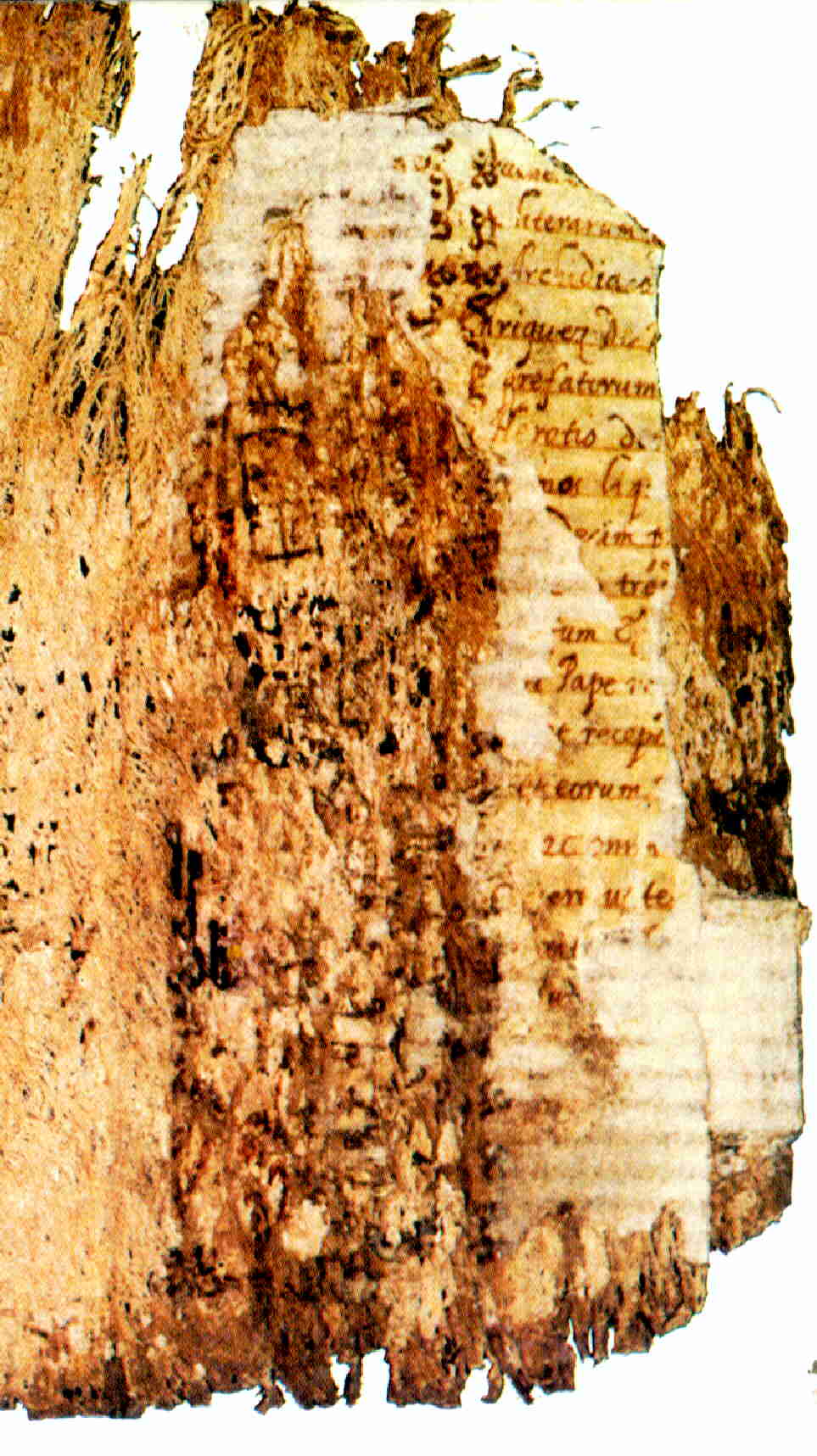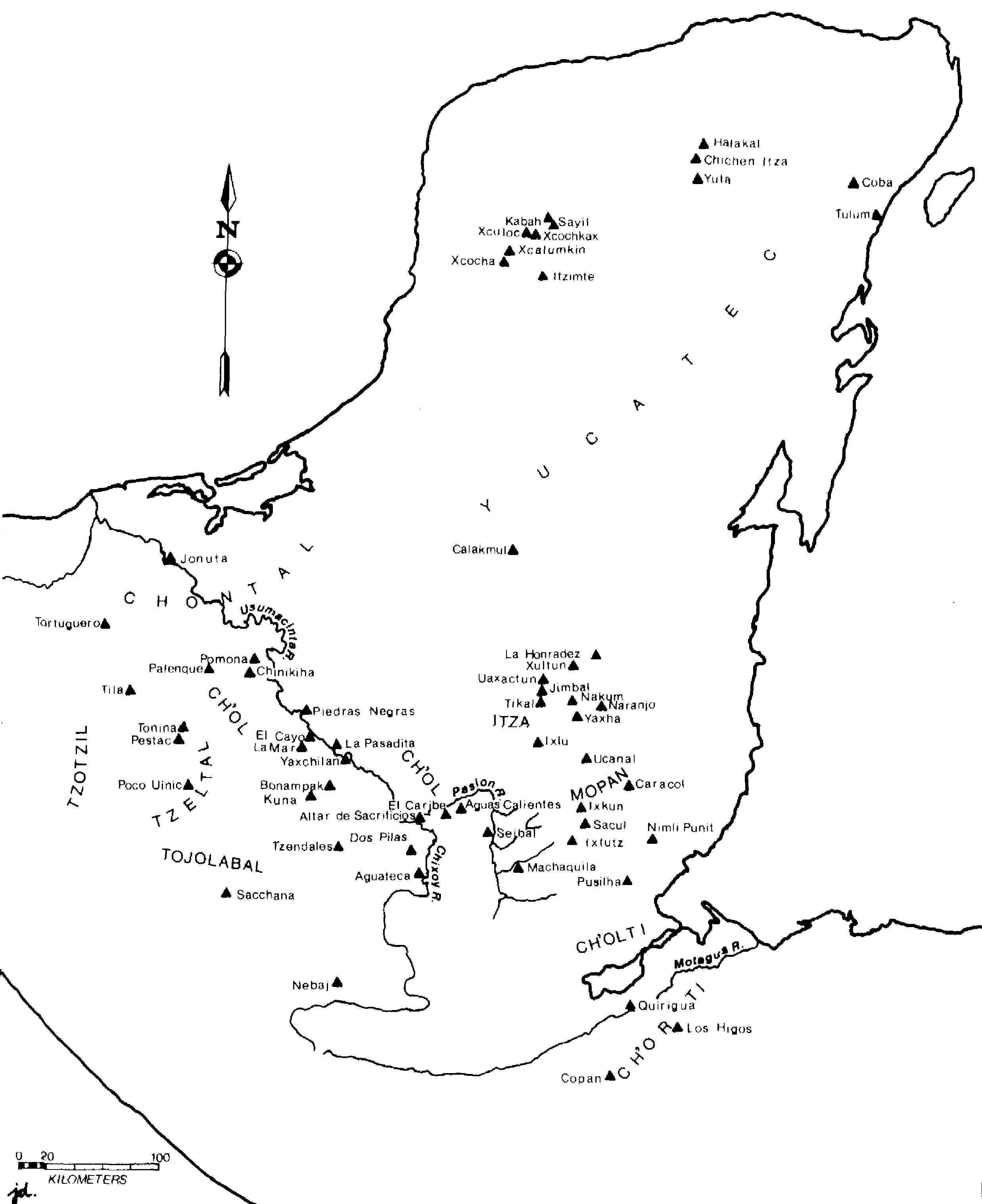
Page 56 of the Madrid Codex with Latin writing. The writing, which appears in mirror image on the original, has been reversed so that the text can be read. After Anders (1967). Courtesy of the Museo de América, Madrid.
We know nothing about the origin and acquisition of the Maya codices (with the exception of the Grolier Codex); as a result, their proveniences are either unknown or uncertain. Analyzing internal evidence contained in the manuscripts themselves, however, has allowed researchers to develop and test theories about the dating and place where these documents were manufactured.
Scholars generally attribute the Dresden, Paris, and Madrid codices to the Late Postclassic period (c. A.D. 1200-1500) on the basis of their painting style. All three may be compared to murals found at Postclassic sites in northern Yucatán such as Tulum, Tancah, Santa Rita, and Mayapán. Both the codices and the murals show evidence of being influenced by the Mixteca-Puebla art style, which spread throughout much of Mesoamerica after A.D. 1100. Until recently, the dating and provenience of the Maya codices have been determined largely on the basis of stylistic comparisons such as these. In 1997, however, several scholars, including Michael Coe and Justin Kerr in the book The Art of the Maya Scribe and James Porter in a separate publication, questioned the supposition that the Madrid Codex is pre-conquest in origin. Instead, they argued that it may have been painted in the Petén region of Guatemala after the conquest of Yucatán. This proposal is challenged in several more recent publications (discussed below; see H. Bricker 2004; Chuchiak 2004; Graff and Vail 2001; Paxton 2004; Vail and Aveni 2004; Vail et al. 2003).
Scholarly opinion has generally favored a pre-conquest date for the Madrid Codex as well, although there have been some dissenting voices. Writing in the 1950s, Thompson outlined two possible proveniences for the manuscript, including (1) northwestern Yucatán in the 15th century, or (2) Tayasal, where it may have been obtained by the Spanish during the 1697 overthrow. He later rejected the second possibility, however, and supported the idea that it originated in western Yucatán. More recently, Michael Coe and James Porter have returned to the possibility of a post-conquest dating of the Madrid Codex and a Tayasal provenience.
Coe’s belief that the Madrid Codex comes from the 17th-century Petén stems from the presence of paper with Latin writing on page 56, which he considers to be integral to the manuscript. Although much of the Latin text cannot be read, Coe identifies part of the name “...riquez” on the fragment of paper that remains. He interprets this as a possible reference to the Franciscan missionary Fray Juan Enríquez, an idea that he attributes to Stephen Houston. Based on the fact that Enríquez was killed in the town of Sacalum in 1624 during an attempt to conquer Tayasal, Coe proposes that the manuscript was produced after this date.

Page 56 of the Madrid Codex with Latin writing. The
writing, which appears in mirror image on the original, has been reversed so
that the text can be read. After Anders (1967). Courtesy of the Museo de América, Madrid.
Porter independently arrived at a similar conclusion, although his argument is based on two objects depicted in the manuscript—what he interprets as a European weapon on page 39b and an idol representing a horse on page 39c . Porter attributes these two scenes directly to Hernan Cortés’ visit to Tayasal in 1525, and therefore dates the painting of the codex to the interval between Cortés’ departure and the conquest of Tayasal in 1697.
More recent studies call these conclusions into question. In an analysis of the material culture represented in the Madrid Codex, Don Graff identified a number of artifacts that are diagnostic of a certain time period in the archaeological record, including specific varieties of incense burners, several drums, a rattle, and a weaving pick. The presence of these items indicates that the Madrid Codex was painted after A.D. 1300. Graff notes, however, that depictions of these artifacts do not rule out the possibility of a post-conquest date, since the Madrid Codex may have been copied from earlier books in which such objects were depicted. Nevertheless, striking parallels between the material culture depicted in the Dresden and Madrid codices, together with astronomical evidence, strongly suggest that the codex is pre-conquest in date. On the basis of these data, Graff and Vail attribute the Madrid Codex to the mid 15th century in their article “Censers and Stars: Issues in the Dating of the Madrid Codex.” This determination can be supported by the artifacts pictured in the manuscript, including the items that Porter attributes to the post-conquest period. As Graff and Vail note, Porter’s identifications of two objects suggesting European influence on page 39 of the codex are highly questionable, and both can be better explained within the framework of Postclassic Maya culture.
Resolving the issue of whether the manuscript is pre- or post-conquest ultimately depends on determining if the paper with the European writing is genuinely integral to the codex (sandwiched between layers of paper with Maya writing) or whether it is a later addition that became attached either intentionally or accidentally. A recent analysis by Harvey Bricker provides what we believe is a definitive answer to this question—the European paper lies on top of the original codex and therefore cannot be used to support a post-conquest dating of the manuscript.
Other research methodologies have been used to determine where the Maya codices originated. Early studies concerning the language of the codical texts suggested a Yucatecan provenience for these manuscripts. This supposition was called into question in the 1990s by Robert Wald and Alfonso Lacadena, who found evidence of Ch’olan as well as Yucatecan texts in the Dresden and Madrid codices. A more recent analysis by Gabrielle Vail indicates that Yucatec was the primary language of the Madrid scribes, based on patterns of verbal inflection and other linguistic indicators. Many of these involve the way that words are formed (inflectional or morphological patterning).
Vail’s analysis of the hieroglyphic texts from the Madrid Codex indicates the presence of vocabulary items from both Yucatec and the Western Ch’olan languages (specifically Chontal), in agreement with Lacadena’s findings. Additionally, there are morphological features suggestive of Yucatec, Eastern Ch’olan (Ch’orti’ and Ch’olti’), and Western Ch’olan (see map below). However, although Ch’olan vocabulary occurs throughout the entire codex, Ch’olan morphology is more limited in its distribution, with Yucatec being predominant.

Map showing the distribution of Maya linguistic groups. After V. Bricker (1986: Fig. 1).
This patterning lends itself to the following scenario. Like most Maya documents, the Madrid Codex consists of a compilation of almanacs and texts that were drafted by different scribes and often copied from earlier sources. This is similar to the patterning seen in Colonial period Yucatec texts, such as the Books of Chilam Balam (discussed below). Because of the predominance of Yucatec morphology, Vail proposes that several, if not all, of the scribes who drafted the Madrid Codex were Yucatec speakers. She interprets the presence of passages that incorporate features from the Eastern Ch’olan languages as indications that certain texts represent copies from earlier manuscripts that were not updated by the copyist. This possibility receives support from a proposal made by Stephen Houston, David Stuart, and John Robertson that the Classic period Maya elite used Ch’olti’an (an Eastern Ch’olan language) as a written language, whether they themselves were Yucatec or Ch’olan speakers. Examples of Eastern Ch’olan morphology in the Madrid Codex, Vail proposes, represent archaisms or holdovers from the Classic period. There is stronger evidence of Western Ch’olan influence, seen both in terms of the presence of the Chontal spelling of the word for ‘rulership’ (ajawle ) throughout the Madrid texts, as well as several passages containing Western Ch’olan morphology. Vail suggests that these data indicate contact between the Madrid scribes and members of the Chontal elite residing along the Gulf coast (see map above).
The patterning described by Vail is analogous in many respects to the use of Spanish loan words (and sometimes complete clauses) in the Colonial Books of Chilam Balam. As Victoria Bricker and Helga-Maria Miram have demonstrated, the Book of Chilam Balam of Kaua represents a compilation of European and native Yucatec texts. In some cases, Spanish texts were copied without translation into the Kaua manuscript, although this often resulted in corrupted spellings. In other instances, Spanish and Latin texts were translated into Yucatec, and there are also occasional examples of only partially translated texts. Bricker compares this to some of the hybrid Ch’olan and Yucatecan texts in the Maya codices described by Vail.
Vail’s model suggests a Yucatecan provenience for the Madrid Codex, but it does not rule out the possibility that it was painted in the Tayasal area of the Petén, since this region was occupied by Itzaj speakers (Itzaj and Yucatec are closely related languages that are both members of the Yucatecan language family). Recent studies by John Chuchiak and Merideth Paxton point away from a Tayasal origin, however, demonstrating instead a close relationship with the northern part of the Yucatán peninsula. Chuchiak provides a compelling analysis of the Latin text on Madrid 56. If his conclusions are correct, it is possible to relate the handwriting of the text to a specific scribe, Gregorio de Aguilar, who was in the eastern part of the Yucatán peninsula in the early 17th century. Recent analyses, therefore, bring questions about the provenience and dating of the Madrid Codex full circle.
Copyright (c) 2002-2013 by Gabrielle Vail, LLC. All Rights Reserved.
Click here for information on how to cite to this website in a publication.